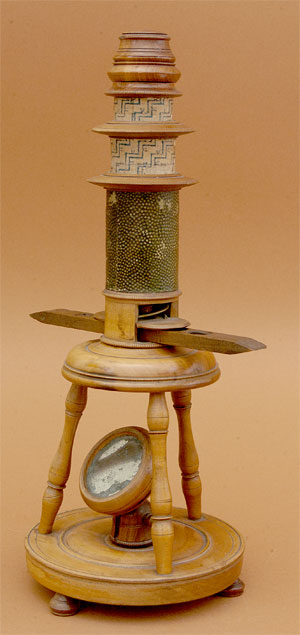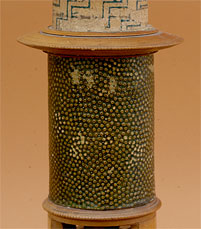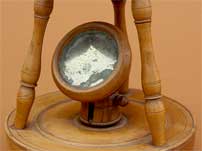 |
|||||
 |
 |
||||
 |
|||||
 |
 |
||||
Nuremberg Three-Pillar Microscope, No. 51 |
|||||||||
 |
Age: c.1830 Made by: unknown Made in: Nuremberg, Germany |
||||||||
 |
|||||||||
|
Shagreen decoration
|
|||||||||
 |
|||||||||
|
Mirror
|
|||||||||
|
This three-pillared microscope was made in or around the town of Nuremberg, Germany by the toy-makers of the area. These craftsmen were, and still are, famous for their wooden toys. Nuremberg microscopes all are constructed with a main body consisting of two draw-tubes made of cardboard with lathe-turned wood trim. This microscope body is inserted into a third tube, which is supported by three turned pillars on a wooden base. Focusing is achieved by sliding the microscope body inside the supportive cardboard tube. The sample remains fixed by a spring stage and is illuminated from below by the substage mirror. In addition, the top tube (holding the eyepiece and field lenses) slides inside the base tube (which holds the objective lens). The optics consist of only three lenses: the eyepiece, field, and objective lens. Samples were mounted in the wooden sample holder and held in place by the Bonanni spring stage. The illuminating mirror is single-sided and mounted on a rotating wooden base. The microscope optical body is 15–18cm long, and the total height of this instrument is appx 32cm. All Nuremberg microscopes have some degree of decoration. This microscope has shagreen covering the support base, and printed paper covering the body tube. This popular style, the shagreen-covered, tripod design, was modeled after the more elegant microscopes by Edmund Culpeper of the early part of the 18th century. Other Nuremberg microscopes are characterized by having a rectangular drum stand or a side pillar design. Many of these instruments have initials burnt into the wood base, some surrounded by a circle, some by a heart shape. These may have been the marks of the sellers or distributors of the product. Unfortunately, this instrument in the Golub Collection does not have any such identification. Although some Nuremberg microscopes are said to have been made in the 18th century, it is likely that most were constructed during the first half of the 19th century. The Golub Collection has examples of all three types. |
|||||||||
| Featured 2/2006; 6/2014, 11/2022 | |||||||||